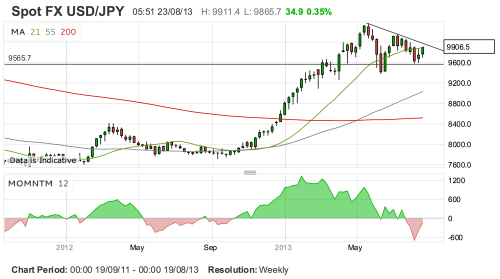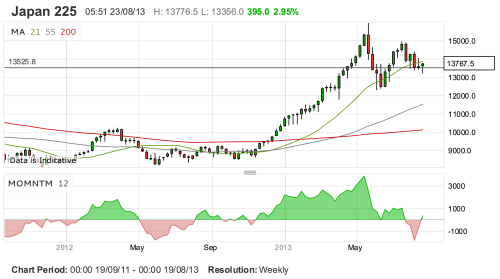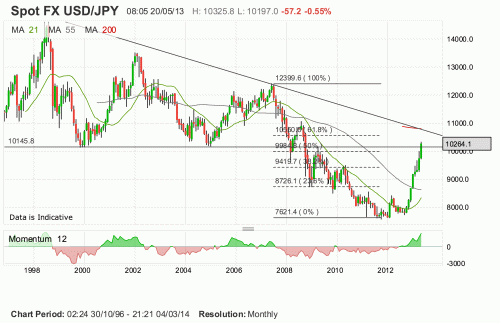Abeconomics, Nikkei, Dollar Yen and tapering
The impact of US monetary policy on global markets remains large. The impact on the Japan financial markets is somewhat counter-intuitive, especially in the light of Abeconomics. Tighter US monetary policy in the face of aggressively easier Japan monetary policy should, prima facie, weaken the Yen. Given the export-oriented aspect of Japan equities this should boost the latter.
The prospect of Abeconomics back in December 2012 did trigger a trend weakening in Dollar Yen and corresponding rally in the Nikkei. It was the prospect of tapering in the US that ended the two trends back in May. This is not a self-evident logical development. The prospect of tighter US monetary policy might reasonably have been expected to accelerate these trends. Indeed it will, and soon.
The end of the Japan market trends back in May was quite logical if all the facts are known and the nature of market dynamics understood. In part it reflects the perceived sensitivity of the Japan economy to global growth. Tapering was taken to mean that one major stimulus to global growth was likely to be removed. A neat narrative but does not really explain the rally in the Yen. The more reasonable explanation was timing and positions.
The Japan market trends had been generated to a large extent by non-domestic portfolio flows. This accumulation of positions had generated good profits. The start of the summer is always a likely time for profit taking. The tapering story injected a degree of uncertainty and triggered profit taking by non-domestics. No doubt this encouraged those domestic investor that had participated in the trends to join the exodus. A correction ensued.
Domestic investors have remained collectively sceptical of Abeconomics. This is to be expected. After 20 odd years of stagnation and of successive governments pursuing fine-sounding but ineffective policies, the cynicism can become imbedded. There is also the prospect of a rise in the consumption tax, an event that has coincided with poor economic developments in the past. As has been argued in a previous blog, the impact of the consumption tax may not be what many fear but one can forgive the locals for not being convinced.
The Abeconomics project still has a number of elements to negotiate, notably tax reform. However, the local investor may soon start to act in tandem, even if sceptical. The stability of the JGB market in the face of rising rates in non-domestic bond markets is generating pressure for portfolio outflows. Such flows have considerable the capacity to weaken the Yen further and, given the evident negative correlation, strengthen the Nikkei.



